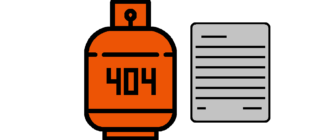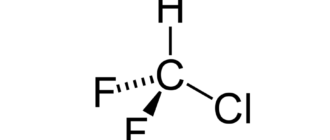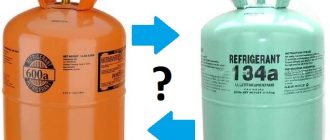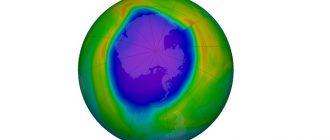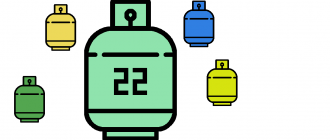Обновлено: 6 May 2022.
How to find out that the air conditioner has run out of freon without special equipment? How to do it yourself without calling a specialist? Why can the refrigerant run out in the air conditioner? In this post, we will describe six ways you can answer questions:
- Is there refrigerant in the air conditioner?
- Is the amount of freon normal?
- Is the air conditioner empty of refrigerant?
Where does freon go?
Some “pseudo-experts” on the Internet say that up to 8% of freon leaves the air conditioner in a year. In reality, this is not the case. Refrigerant is not a fuel; it should not go anywhere from the system. It circulates in a vicious circle.
Freon is under high pressure in the air conditioner. If a leak or microcrack occurs somewhere, it leaves the system. The rate of loss depends on the type of freon and the size of the leak. It can come out in a few minutes, or it can take months.
You must understand that finding out that it is little or no freon is only part of the story. To solve the problem, you need to call a specialist who must:
- Determine the location of the leak;
- Eliminate leakage or crack;
- Top up or completely refill the air conditioner.
Freon is not present at all, or is it not enough?
When there is no freon in the air conditioner, it does not work as if it were not there at all. If there is a lack of refrigerant, this is due to one of two reasons:
- There is a small leak;
- When installing or repairing, a little freon was filled.
If there is a small leak, you will not immediately notice a change in the air conditioner’s operation. It will gradually cool or heat the air worse. If you see such a drop in performance, most likely, there is a depressurization of the system somewhere.
If your air conditioner was diagnosed, they did routine maintenance. It may not have enough refrigerant pumped into it. You will feel the difference in work efficiency immediately. And if the specialist says, “later it will start working normally” or “you have to wait a few days” – these are fairy tales. Such a master must be driven away.
Decreased efficiency
The efficiency (COP) loss is the first sign of an air conditioner problem. If it starts to heat or cool worse, it is not a fact that the problem is with the refrigerant. In addition to its lack, there may be several reasons:
- The radiator of the outdoor unit is clogged;
- The dirty evaporator of the indoor unit;
- Clogged air mesh filters;
- The wrong temperature was selected.
To pinpoint the cause, clean the evaporator, condenser, and air conditioner filters. If this does not help, take a look at the instructions. Each air conditioner has limit operating modes. Its efficiency depends on the temperature difference between the room and the outside.
The air conditioner will not be able to cool the room well when it is hot outside. Also, it will not work well for heat when it is cold outside. The greater difference between the temperatures inside and outside the room, the lower the COP of the air conditioner (conversion coefficient, similar to efficiency).
If the operating conditions are within limits specified in the instructions, the radiators and filters are clean, most likely the problem is a lack of refrigerant.
Snow check
If there is little refrigerant in the air conditioner, it starts to work at the limit of possibilities. The following happens:
- There is not enough refrigerant to cool or heat the room;
- The compressor starts to work at a higher speed, turns on more often;
- Freon circulates quickly through the system;
- It cools too much in the heat exchanger;
- Snow, frost, and ice form on the grate;
- Frost interferes with air cooling, which further reduces efficiency.
It takes some time for ice to form on the evaporator or condenser grate. Turn on the air conditioner for half an hour. Then check for frost on the evaporator or condenser grilles.
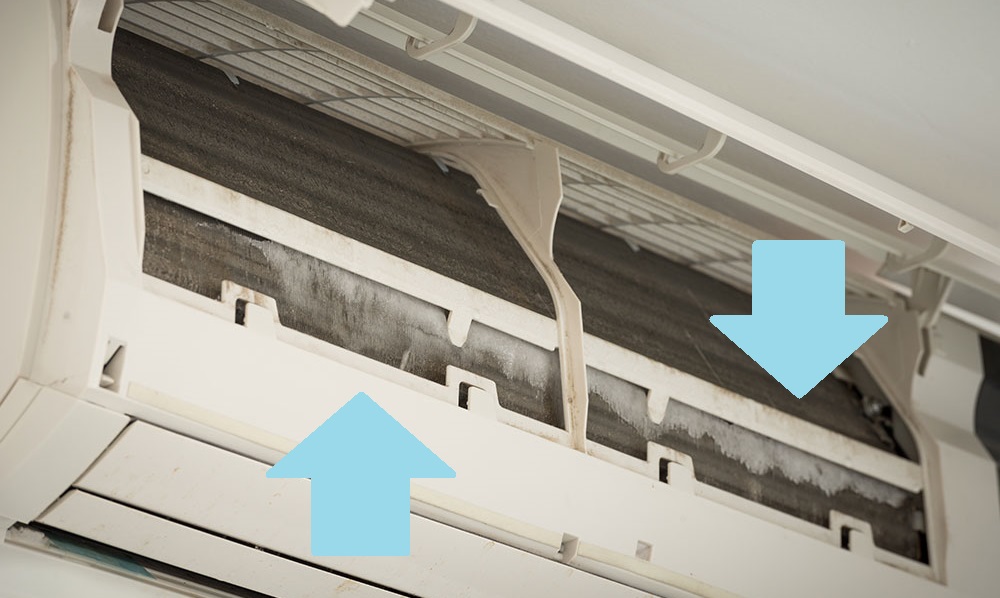
When operating in cold conditions, the air conditioner’s lack of freon causes the evaporator’s icing in the indoor unit. It is easy to check this:
- Open the front cover of the indoor unit by pulling the tabs on the sides;
- Remove mesh filters;
- Examine the evaporator radiator.
When the air conditioner is running on heat, ice will form on the condenser. It is located at the back of the outdoor unit. You can look at it in a split system both from the unit’s front side and from the back. In other types of air conditioners, it can be located in different ways.
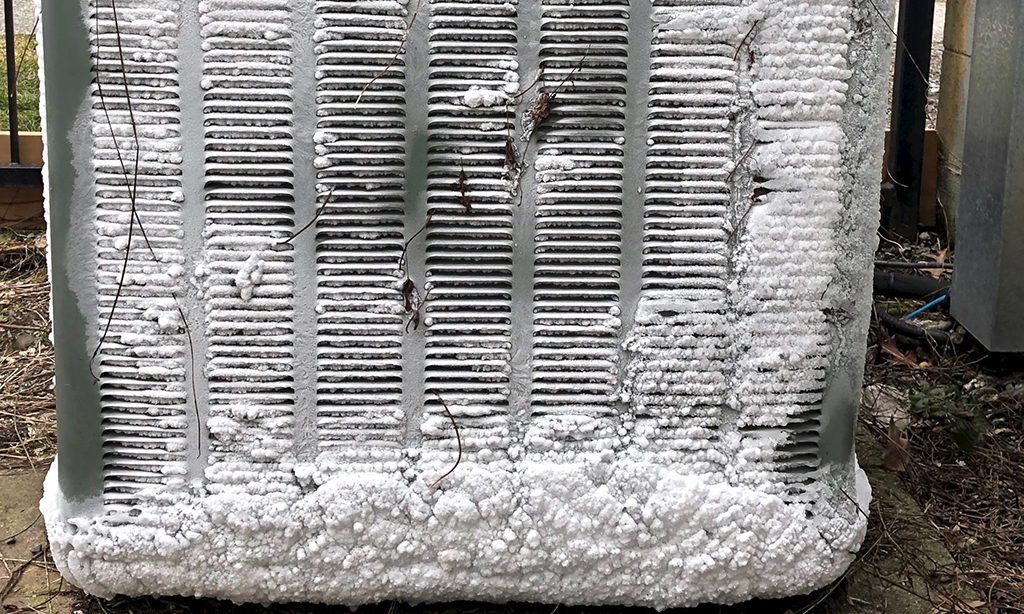
Compressor
There are two types of compressors – conventional and inverter. Conventional operates in On / Off or Start / Stop mode. It turns on for a certain time, brings the refrigerant to the desired temperature, and turns off. Switching frequency and operating time depends on:
- Air conditioner capacity;
- Freon type;
- Indoor and outdoor temperature differences.
The inverter compressor runs continuously. But its speed depends on the temperature regime. When you turn on the air conditioner, it runs faster to cool or warm the room. As soon as the temperature reaches the set temperature, the compressor slows down and works to maintain it.
Advice
You can find out what type of compressor is in your air conditioner by looking at the indoor or outdoor unit’s sticker. Inverter models are marked with the corresponding inscription “INVERTOR”. If not, you will see the air conditioner’s model on the sticker, and you can see its characteristics on the Internet.
If you have access to the outdoor unit, check how the compressor is working. To do this, set the maximum blowing speed. If it happens in the summer, set the minimum temperature when operating in the cold. If in winter – the maximum temperature when working for heat.
The average running-to-downtime ratio of a conventional compressor is 1 to 3. Note how often it is turned on. It can be determined by the sound, vibration of the outdoor unit. If it works most of the time, there is a lack of refrigerant. If it works continuously, freon, most likely, has left the system entirely.
An inverter compressor with a lack of freon will work at high speed. The less refrigerant in the system, the higher it is. If the room temperature has reached the set one, and the compressor is operating at high speed, there is a lack of refrigerant.
Checking line temperature
The refrigerant is continuously circulating between the indoor and outdoor units of the air conditioner. They are connected by a freon line made of copper pipes. In normal mode, the temperature of the tubes is very different. One will be much colder than the other.
If the freon is entirely out of the air conditioner, the tubes’ temperature will be approximately the same. But this is only when the compressor is running. Accordingly, if the compressor has not failed and the tubes are of roughly the same temperature, then there is no freon in the system.
Search for leaks
The refrigerant in the air conditioner mixes with the oil. As mentioned above, it can only leave the system due to a leak. In this case, the oil forms a small stain at the place of depressurization. You can find it by visual inspection.
If there is access to the freon pipeline, inspect it. Do this carefully along the entire length. A little compressor oil comes out, and you can skip the leak. Especially carefully check the joints of the pipes with the compressor, evaporator, and condenser.
Lifehack
If during the check you find that ice or snow has formed in someplace – you are in luck! Most likely, you have found the place of the freon leak. But only if the ice is local does not spread along the length of the pipe, the condenser, or evaporator’s area.
Checking the valves of the outdoor unit
Another way to find out if it is little or no refrigerant in the air conditioner is to check the valves of the outdoor unit. They are located at the bottom, on the right side, and can be covered with a protective cover (see photo). This option works best during the warmer months.
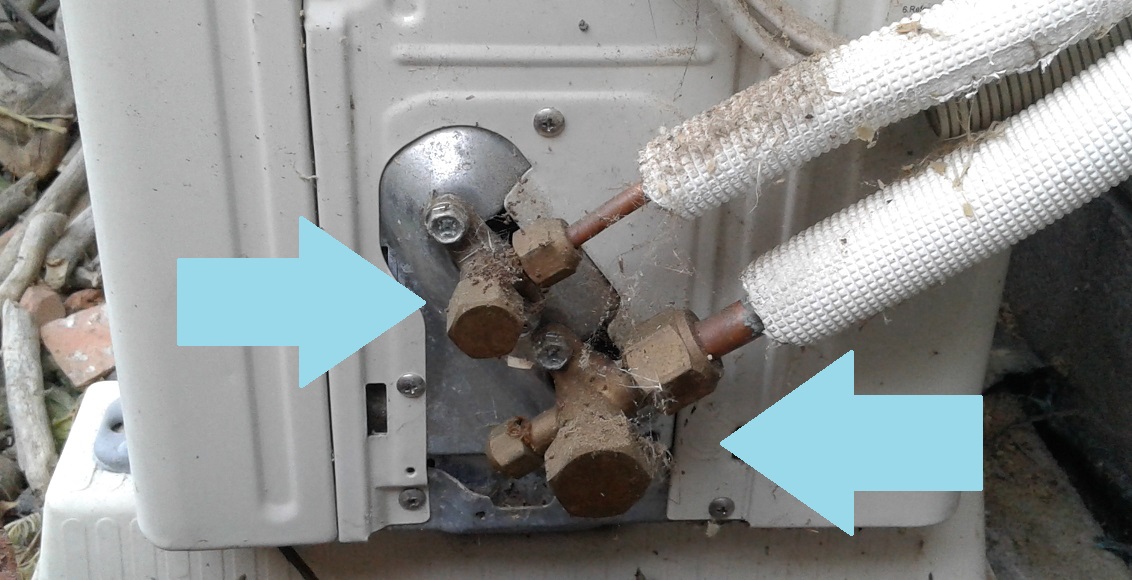
Before checking:
- Turn on the air conditioner at full power and set the minimum temperature.
- Let it run for 5-10 minutes.
- Pay attention to the valves. If condensation has accumulated on them, they have cooled down – everything is in order, there is refrigerant in the system.
If there is no condensation on the service valves and their temperature has not changed, the freon has wholly left the air conditioner. If frost or ice forms on the valves’ surface, there is not enough refrigerant in the system. Ice forms for the same reason as in the outdoor unit.
With this publication, we answered how to find out that the air conditioner has run out of freon. Perhaps you know other ways? You can leave your opinion and questions in the comments. Don’t forget to share this article with your friends and colleagues!
Хотите получить помощь мастера, специалиста в этой сфере? Переходите на портал поиска мастеров Профи. Это полностью бесплатный сервис, на котором вы найдете профессионала, который решит вашу проблему. Вы не платите за размещение объявления, просмотры, выбор подрядчика.
Если вы сами мастер своего дела, то зарегистрируйтесь на Профи и получайте поток клиентов. Ваша прибыль в одном клике!
